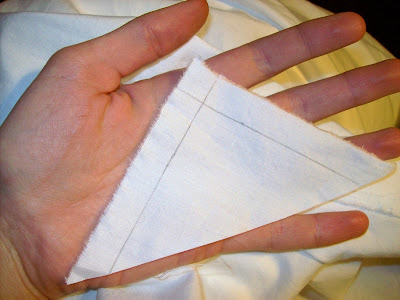I'm currently making a 19th century chemise to use for reenacting. I just set gussets into it and want to show exactly how I did it for future reference and also to open discussion for different methods. Maybe there is a way that is easier or more effective. I welcome input! First, I cut these triangular gussets. They are four inches on each side. The lines mark the seam half an inch from each edge, wide enough to fell the seam to hide raw edges. Lines aren't necessary, but make it easier to align the gusset perfectly and also show exactly how I did this process. This is the slit into which I am inserting the gussets, cut along the grain. Notice how it is a cut slit, not an open seam. That made the process slightly more challenging since the raw edges of the slit were facing toward the gusset, in contrast to a seam, where there would be a folded edge facing the gusset. I set the gusset piece like so, right sides facing, and stitched...











Kaela.. You are amazing.. I loved this. As you know I love hand stitching .but certainly too hot this summer to quilt.. I should learn to tat so I can carry it.. Maybe some lessons someday... Hard to find good wool miss your smile barb
ReplyDeleteThanks! Sure is nice to hear from you!
DeleteI need you to teach me how to do buttonholes! They are simply awesome!!!
ReplyDeleteThank you! If you live anywhere near Pittsburgh or Buffalo, I could teach you!
Delete